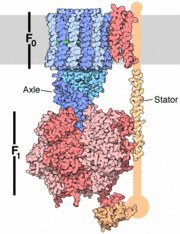A-ATP Synthase
From Proteopedia
| Line 6: | Line 6: | ||
<StructureSection load=1e79 size='500' side='right' caption='F1-ATP synthase motor domain', ([[1e79]])' scene=''> | <StructureSection load=1e79 size='500' side='right' caption='F1-ATP synthase motor domain', ([[1e79]])' scene=''> | ||
| - | == | + | ==<scene name='A-ATP_Synthase/Rotary_stalk/1'>F1 ATP Synthase Rotary Mechanism</scene>== |
| - | The central stalk in ATP synthase, made of gamma, delta and epsilon subunits in the mitochondrial enzyme, is the key rotary element in the enzyme's catalytic mechanism. The | + | The central stalk in ATP synthase, made of gamma, delta and epsilon subunits in the mitochondrial enzyme, is the key rotary element in the enzyme's catalytic mechanism. The <scene name='A-ATP_Synthase/Rotary_stalk/2'>Gamma subunit</scene> penetrates the catalytic (alpha beta)(3) domain and protrudes beneath it, interacting with a ring of c subunits in the membrane that drives rotation of the stalk during ATP synthesis. The delta and epsilon subunits interact with a Rossmann fold in the gamma subunit, forming a foot. In ATP synthase, this foot interacts with the c-ring and couples the transmembrane proton motive force to catalysis in the (<scene name='A-ATP_Synthase/Rotary_stalk/4'>alpha</scene> <scene name='A-ATP_Synthase/Rotary_stalk/3'>beta</scene>)(3) domain. |
When operating as a generator, it uses the power of rotational motion to build ATP, or when operating as a motor, it breaks down ATP to spin the axle the opposite direction. The synthesis of ATP requires several steps, including the binding of ADP and phosphate, the formation of the new phosphate-phosphate bond, and release of ATP. As the axle turns, it '''forces the motor into three different conformations that assist these difficult steps.''' | When operating as a generator, it uses the power of rotational motion to build ATP, or when operating as a motor, it breaks down ATP to spin the axle the opposite direction. The synthesis of ATP requires several steps, including the binding of ADP and phosphate, the formation of the new phosphate-phosphate bond, and release of ATP. As the axle turns, it '''forces the motor into three different conformations that assist these difficult steps.''' | ||
Revision as of 19:31, 28 November 2011
Structure
The structure on the right shows the F1 motor and the axle that connects the two. ATP synthesis is composed of two rotary motors, each powered by a different fuel. The motor at the top, termed F0, an electric motor. It is embedded in a membrane (shown schematically as a gray stripe here), and is powered by the flow of hydrogen ions across the membrane. As the protons flow through the motor, they turn a circular rotor . This rotor is connected to the second motor, termed F1. The F1 motor is a chemical motor, powered by ATP. The two motors are connected together by a stator, shown on the right, so that when F0 turns, F1 turns too. A-ATP synthase is very similar to F ATP Synthase and is composed of two parts A1 and A0 which are composed of at least nine subunits A3B3C:D:E:F:H2:a:cx that function as a pair of rotary motors connected by central and peripheral stalk(s) [1]. The A0 domain is the hydrophobic membrane embedded ion-translocating sector that uses the H+ gradient to power ATP synthase in domain A1. A1 is catalytic and water soluble containing A and B subunits. These subunits are comparable to F-ATP synthase ATP synthase alpha/beta subunits. The A subunit of A1 is catalytic and the B subunit is regulatory, with a substrate-binding site on each. [1]
| |||||||||||
| |||||||||||
| |||||||
| Transition state, 1e79 | |||||||
|---|---|---|---|---|---|---|---|
| Ligands: | , , , , , | ||||||
| Activity: | H(+)-transporting two-sector ATPase, with EC number 3.6.3.14 | ||||||
| Related: | 1bmf, 1cow, 1e1q, 1e1r, 1efr, 1nbm, 1qo1
| ||||||
| |||||||
| Resources: | FirstGlance, OCA, RCSB, PDBsum | ||||||
| Coordinates: | save as pdb, mmCIF, xml | ||||||
Contents |
References
- ↑ 1.0 1.1 Muller V, Lemker T, Lingl A, Weidner C, Coskun U, Gruber G. Bioenergetics of archaea: ATP synthesis under harsh environmental conditions. J Mol Microbiol Biotechnol. 2005;10(2-4):167-80. PMID:16645313 doi:10.1159/000091563
- ↑ Gibbons C, Montgomery MG, Leslie AG, Walker JE. The structure of the central stalk in bovine F(1)-ATPase at 2.4 A resolution. Nat Struct Biol. 2000 Nov;7(11):1055-61. PMID:11062563 doi:10.1038/80981
- ↑ Schafer IB, Bailer SM, Duser MG, Borsch M, Bernal RA, Stock D, Gruber G. Crystal structure of the archaeal A1Ao ATP synthase subunit B from Methanosarcina mazei Go1: Implications of nucleotide-binding differences in the major A1Ao subunits A and B. J Mol Biol. 2006 May 5;358(3):725-40. Epub 2006 Mar 10. PMID:16563431 doi:http://dx.doi.org/10.1016/j.jmb.2006.02.057
- ↑ Gonzalez JM, Masuchi Y, Robb FT, Ammerman JW, Maeder DL, Yanagibayashi M, Tamaoka J, Kato C. Pyrococcus horikoshii sp. nov., a hyperthermophilic archaeon isolated from a hydrothermal vent at the Okinawa Trough. Extremophiles. 1998 May;2(2):123-30. PMID:9672687
- ↑ Manimekalai MS, Kumar A, Jeyakanthan J, Gruber G. The Transition-Like State and P(i) Entrance into the Catalytic A Subunit of the Biological Engine A-ATP Synthase. J Mol Biol. 2011 Mar 16. PMID:21396943 doi:10.1016/j.jmb.2011.03.010
- ↑ Priya R, Kumar A, Manimekalai MS, Gruber G. Conserved Glycine Residues in the P-Loop of ATP Synthases Form a Doorframe for Nucleotide Entrance. J Mol Biol. 2011 Sep 8. PMID:21925186 doi:10.1016/j.jmb.2011.08.045
- ↑ Manimekalai MS, Kumar A, Jeyakanthan J, Gruber G. The Transition-Like State and P(i) Entrance into the Catalytic A Subunit of the Biological Engine A-ATP Synthase. J Mol Biol. 2011 Mar 16. PMID:21396943 doi:10.1016/j.jmb.2011.03.010
Proteopedia Page Contributors and Editors (what is this?)
Kaitlin Chase MacCulloch, Michal Harel, Alexander Berchansky


